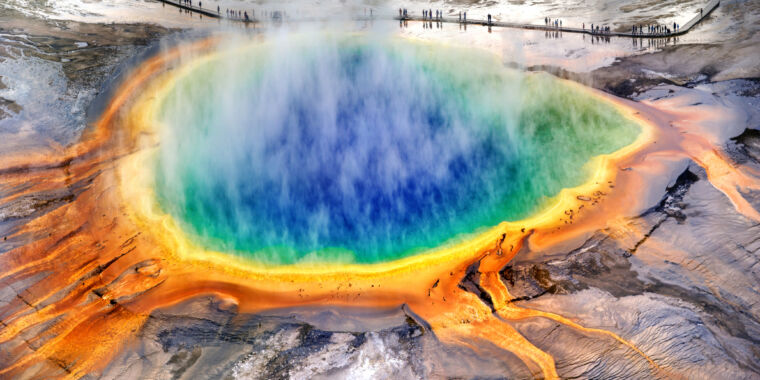
The massive volcanic caldera in Yellowstone National Park is just the latest in a long line of volcanic sites, all of which appear to be connected by a hot blob of material that can go all the way down to Earth’s mantle. A lot of effort has gone into tracing that hot material, as some of its previous eruptions were massive.
But there’s also a connection between that hot material and the features, such as geysers and hot springs, that make Yellowstone a major tourist destination. And those connections are very difficult to trace. But a new study has proposed a map showing how Yellowstone’s hot water flows beneath visitors’ feet and why it surfaces in specific locations.
Mapping the plumbing
We tend to talk about water beneath our feet as traveling through underground rivers, but that paints a misleading picture. In reality, water creeps like a broad stream through permeable materials, its path shifted by things like fractures and hard, impenetrable rock, like granite. Tracking isn’t the easiest.
To get a good picture of Yellowstone, the researchers flew a helicopter over the caldera along a series of lines spaced just 250 meters apart. On board was an instrument sensitive to electromagnetic fields, which measured the resistivity and magnetic sensitivity of the area below the helicopter. With all that data in hand, the researchers were able to construct a model of the properties down to a few hundred meters below the surface.
Water is a very polar liquid, which will change the electromagnetic properties of all the rocks it flows through. Water that has interacted with the hot rocks beneath Yellowstone will contain a lot of dissolved material, altering the water’s electrical conductivity even further.
We know something about the structure of the rocks beneath Yellowstone from drilling holes at specific locations on the site. There are older consolidated rocks, loose volcanic tuff produced by explosive eruptions and a variety of clays, which may or may not contain hot water. Information about all of these materials helped inform the three-dimensional model the researchers produced.
There’s a lot going on
As you might expect, there was evidence of broad areas filled with hot water beneath many of the caldera’s geyser basins. But these areas were often not directly below the geyser fields themselves. Instead, they were often capped by rocks and clay that did not allow a smooth updraft. In many cases, the hot water moved up through fractures that created holes in the otherwise impenetrable rock — the fractures appeared as sharply defined streaks of hot water.
Once closer to the surface, the hot water often ran into a cap of impenetrable volcanic deposits. In general, the geyser fields are defined as an opening in these deposits through which hot water can reach the surface over a relatively large area.
In addition to feeding geyser fields, some of the hot water moved horizontally along lines of permeable material closer to the surface. Sometimes this led to hot water from multiple faults mixing before emerging at a geyser. In other cases, the hot water mixes with the groundwater present in the area, creating moderate temperatures that feed the hot springs around the caldera. In some places, this warm water flowed straight from the area covered by the helicopter.
The resolution on this imaging isn’t great, and many of the details (such as the reservoirs and fissures under individual geysers) can’t be resolved. But the imaging does help to understand some of the phenomena we’ve already observed. It shows that a location associated with swarms of small earthquakes under Yellowstone Lake is an area where hot water moves to the surface. The association between some geysers and specific springs may help explain the difference in the mineral composition dissolved in the water at the different locations.
So while the new work isn’t a complete picture of Yellowstone, it puts together bits of information we already have and could help future efforts to understand one of North America’s most iconic volcanoes.
Nature, 2022. DOI: 10.1038/s41586-021-04379-1 (About DOIs).

